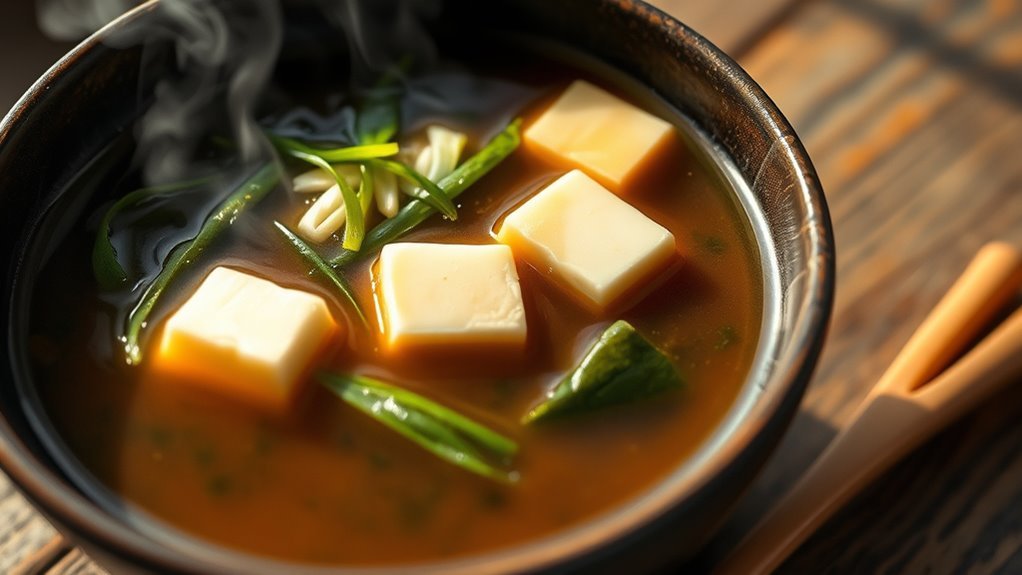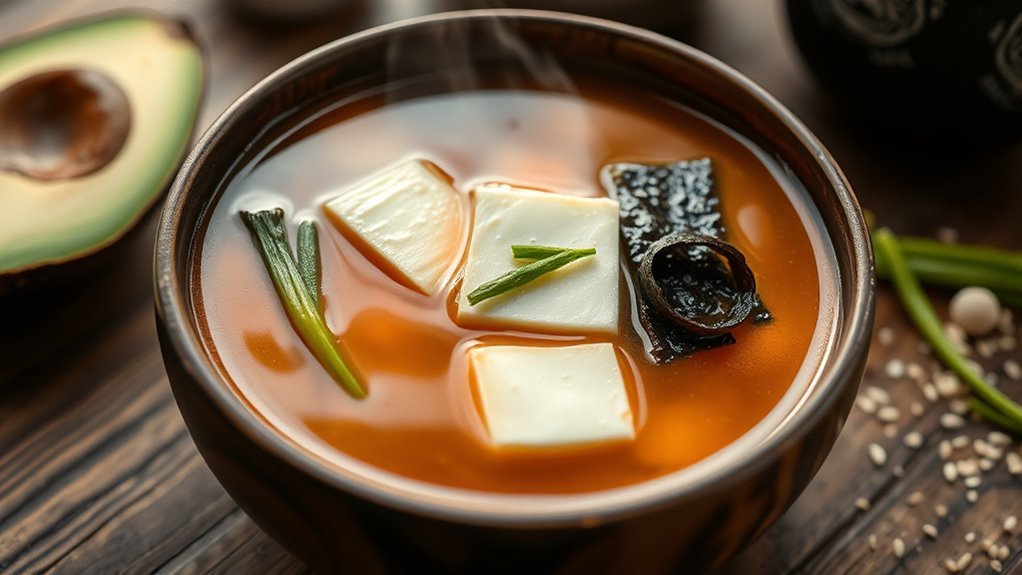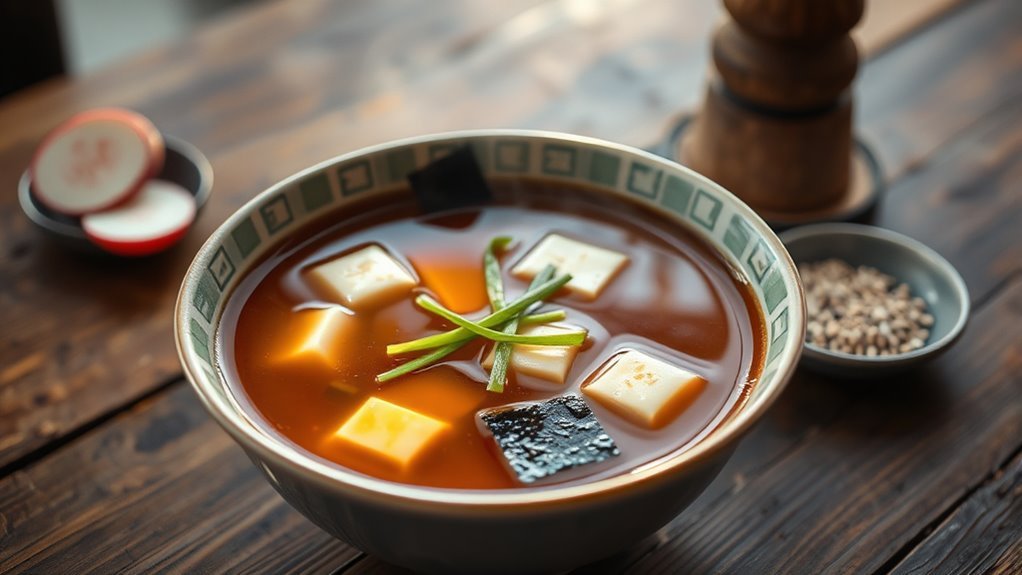Miso soup can be keto-friendly if you choose low-carb ingredients and control portion sizes. Traditional miso contains some carbohydrates, usually ranging from 2-3 grams per serving, but you can alter the recipe by using almond or sunflower seed butter as a miso substitute. Avoid high-carb additions like noodles or rice, and focus on keto-friendly toppings such as green onions and mushrooms. If you’re curious about customizing your miso soup further, there are plenty of tips to explore.
What Is Miso Soup?

Miso soup, a traditional Japanese dish, is a savory broth made primarily from miso paste, which is fermented soybeans. Its origins trace back to ancient China, influencing Japan’s culinary landscape. Miso varies in flavor and color, including white, yellow, and red types, each offering distinct tastes and nutritional profiles. You might find regional soup variations that incorporate ingredients like tofu, seaweed, or green onions, adapting to local tastes. This adaptability is part of miso soup’s charm, allowing it to fit into various diets and preferences. While it’s primarily enjoyed as a comforting dish, the balance of umami flavors makes it a versatile option in any meal. Overall, miso soup’s rich history and diverse variations make it a beloved staple.
Key Ingredients in Miso Soup

A delicious bowl of miso soup typically features a few key ingredients that contribute to its rich flavor and nutritional value. The base is miso, a fermented soybean paste, with common miso types including white (shiro), yellow, and red (aka), each offering distinct tastes. Next, dashi, a Japanese stock made from kombu (seaweed) and bonito flakes, adds depth. Tofu, often soft or silken, provides protein and texture, while green onions give a fresh bite. You can also find variations with vegetables like mushrooms or seaweed, which enhance both flavor and nutrients. Each soup variation allows for creativity while maintaining the essence of miso soup, making it a great choice for those seeking a satisfying, flavorful dish.
Nutritional Profile of Miso Soup

When considering miso soup’s nutritional profile, you’ll find it’s relatively low in carbohydrates, making it a potential fit for a keto diet. Typically, a serving contains about 3 grams of carbs, while also providing a modest amount of protein and minimal fat. This balance can be beneficial, but it’s important to evaluate portion sizes and additional ingredients you might include.
Carbohydrate Content Analysis
Although many people enjoy miso soup for its rich flavor and health benefits, it’s important to assess its carbohydrate content, especially for those following a ketogenic diet. The carbohydrate types in miso soup can vary based on the miso variations used, affecting your overall carb intake.
Here’s a quick breakdown of what to evaluate:
- Traditional Miso: Typically has higher carbs due to fermentation.
- White Miso: Generally lower in carbs than red miso.
- Red Miso: Contains more carbs and sodium.
- Barley Miso: Higher in carbohydrates due to the barley content.
- Soybean Miso: A common choice with moderate carb levels.
Protein and Fat Levels
While miso soup is often celebrated for its umami flavor and health benefits, understanding its protein and fat levels is essential for those adhering to a ketogenic diet. Typically, miso contains around 3 grams of protein per serving, primarily from soybeans, a notable protein source. However, it lacks the high protein levels found in meats or tofu, which may be necessary for your keto goals.
Regarding fat types, miso soup generally has low fat content, around 1 gram, depending on added ingredients like seaweed or tofu. If you’re looking to boost fat levels, consider adding avocado or coconut oil. Balancing protein and fat in your miso soup can help you align it with your keto lifestyle while enjoying its rich flavors.
Carbohydrate Content and Keto Compatibility
How does miso soup stack up regarding carbohydrate content for those following a keto diet? Generally, miso soup can be keto-friendly due to its low carbohydrate levels, but it’s essential to take into account several factors:
- Miso Fermentation: Miso is fermented, which can help with digestion and may influence carb absorption.
- Carbohydrate Count: A typical serving has about 2-3 grams of carbs, making it manageable within a keto framework.
- Sodium Content: Miso soup can be high in sodium, so be cautious if you’re monitoring salt intake.
- Ingredients: Additional ingredients like tofu or seaweed can add minimal carbs while providing nutrients.
- Serving Size: Stick to a moderate serving to keep your carb intake in check.
Health Benefits of Miso Soup
Miso soup offers a range of health benefits that can enhance your overall well-being, especially when incorporated into a balanced diet. Rich in probiotics, miso health supports gut health and digestion, promoting a balanced microbiome. Additionally, the antioxidants found in miso can help combat oxidative stress and inflammation in your body. The soup is also low in calories while being nutrient-dense, providing essential vitamins and minerals like vitamin K and manganese. By enjoying miso soup, you may experience improved immune function and enhanced energy levels. Furthermore, its comforting nature can contribute to emotional well-being. With these soup benefits, you’re not just savoring a delicious dish, but also nourishing your body in a way that aligns with your health goals.
Tips for Making Keto-Friendly Miso Soup
To create a keto-friendly version of miso soup, you’ll want to focus on modifying the traditional recipe to keep the carbohydrate count low while still preserving its rich flavors. Here are some tips to help you along the way:
- Use miso alternatives like almond or sunflower seed butter for lower carbs.
- Choose a low-sodium vegetable or bone broth as your base.
- Incorporate keto toppings such as sliced green onions, mushrooms, or tofu.
- Add leafy greens like spinach or kale for added nutrition without extra carbs.
- Limit or omit ingredients like noodles or rice that can spike your carb intake.
Serving Suggestions for Miso Soup on a Keto Diet
While enjoying miso soup on a keto diet, consider pairing it with complementary dishes that enhance its flavor and maintain your carbohydrate goals. For miso toppings, opt for sliced green onions, seaweed, or soft-boiled eggs. These additions not only elevate the soup’s taste but also provide healthy fats and nutrients. As for soup pairings, a side of grilled chicken or tofu can round out your meal, supplying protein without adding carbs. You might also enjoy a small serving of sautéed vegetables like spinach or zucchini for added fiber. These suggestions help you savor your miso soup experience while sticking to your keto lifestyle, ensuring you feel both satisfied and energized. Enjoy the freedom to explore various combinations!
Potential Considerations for Miso Soup Consumption
When enjoying miso soup, it’s important to contemplate a few factors that can impact its suitability for your keto diet. While miso can provide health benefits, there are some considerations to keep in mind:
- Sodium content: Miso is typically high in sodium, which can affect blood pressure.
- Fermentation: The fermentation process may cause digestive sensitivity in some individuals.
- Carbohydrates: Miso contains carbs; portion control is essential to stay within your daily limit.
- Allergies: Soy allergies are common, and miso is soy-based.
- Additives: Check for any added sugars or ingredients that may not align with keto principles.
Other Keto-Friendly Alternatives to Miso Soup
If you’re looking for keto-friendly alternatives to miso soup, consider trying bone broth variations, which are rich in nutrients and low in carbs. Vegetable broth recipes can also be a great option, allowing you to customize flavors while keeping it healthy. Additionally, creamy coconut soups offer a satisfying, low-carb choice that’s both delicious and filling.
Bone Broth Variations
Bone broth variations offer a multitude of keto-friendly alternatives to miso soup, making them a great option for those following a low-carb diet. Packed with nutrients, bone broth boasts numerous benefits, such as supporting gut health and boosting immunity. Here are some delicious bone broth recipes you can try:
- Chicken Bone Broth: Rich in collagen and protein, perfect for a comforting base.
- Beef Bone Broth: Hearty and flavorful, great for stews or sipping.
- Turkey Bone Broth: A festive twist, ideal post-holiday meals.
- Fish Bone Broth: Light and packed with omega-3s, excellent for seafood lovers.
- Vegetable-Infused Bone Broth: Add your favorite low-carb veggies for extra flavor.
These variations keep your meals exciting while adhering to your keto lifestyle!
Vegetable Broth Recipes
While miso soup is a popular choice, you might find that vegetable broth can also provide a delicious, keto-friendly alternative packed with flavor and nutrients. Vegetable broth is low in calories and carbohydrates, making it an excellent choice for those on a keto diet. Plus, it offers various broth benefits, such as improved digestion and hydration.
Here are some veggie broth recipes to try:
| Recipe | Key Ingredients |
|---|---|
| Classic Vegetable Broth | Carrots, celery, onion |
| Spicy Garlic Broth | Garlic, ginger, chili flakes |
| Herbed Green Broth | Spinach, parsley, basil |
Incorporating these recipes into your meal plan can enhance your diet while keeping it keto-friendly. Enjoy the freedom to create flavorful dishes!
Creamy Coconut Soups
Although miso soup is a beloved staple in many diets, creamy coconut soups can serve as a delicious and keto-friendly alternative. These soups are rich in healthy fats and flavor, making them perfect for your low-carb lifestyle. Here are some great soup recipes to explore:
- Thai Coconut Soup: Infused with lemongrass and lime, it’s a vibrant option.
- Creamy Coconut Curry Soup: A comforting dish packed with spices and vegetables.
- Coconut Tomato Basil Soup: A unique twist that blends creamy coconut with fresh herbs.
- Keto Creamy Mushroom Coconut Soup: Earthy mushrooms pair beautifully with coconut milk.
- Coconut Chicken Soup: A hearty choice full of protein and flavor.
Experimenting with these creamy coconut soups can keep your meals exciting while staying keto-friendly!
Frequently Asked Questions
Can I Add Tofu to My Keto Miso Soup?
When it comes to adding tofu to your miso soup, you’re definitely on the right track. Tofu varieties, like silken or firm, bring a wealth of nutritional benefits, including protein and healthy fats, which can keep you feeling full. Just remember, not all tofu is created equal, so choose wisely. With that said, incorporating tofu into your soup can elevate both its flavor and health profile, making it a fantastic addition to your meal.
Is Store-Bought Miso Soup Keto-Friendly?
When considering store-bought miso soup, it’s essential to check its nutritional content. Many options are low in carbs, making them suitable for a keto lifestyle. However, some brands may add sugars or other high-carb ingredients, so always read the labels. You can enjoy the convenience of store-bought varieties, but opting for those with clear low-carb options guarantees you stay on track without sacrificing flavor or freedom in your diet.
How Long Does Homemade Miso Soup Last?
Homemade miso soup typically lasts about 3 to 5 days in the fridge when stored properly. For ideal miso soup storage, make sure it’s in an airtight container to prevent contamination. If you want to extend its shelf life, you can freeze it, where it may last up to a month. Just remember, the texture and flavor might change slightly after thawing, but it’ll still be delicious. Enjoy your soup!
Can I Use Different Types of Miso Paste?
Absolutely, you can use different miso types in your soup! Each variety, like white, yellow, or red miso, brings unique flavor profiles that can enhance your dish. For example, white miso is milder and sweeter, while red miso offers a robust, savory taste. Mixing them can create a balanced depth of flavor. Just remember, the saltiness varies, so adjust your seasoning accordingly. Enjoy experimenting and discovering which combinations resonate with your palate!
Are There Any Allergens in Miso Soup?
You might think miso soup’s just a harmless bowl of warmth, but it can pack a punch when it comes to potential allergens. The primary miso ingredients include fermented soybeans, which means if you’re allergic to soy, you should tread carefully. Additionally, some recipes might include seaweed, fish, or even gluten-containing ingredients. Always check labels or ask about components to guarantee your cozy soup doesn’t turn into an allergic surprise!


